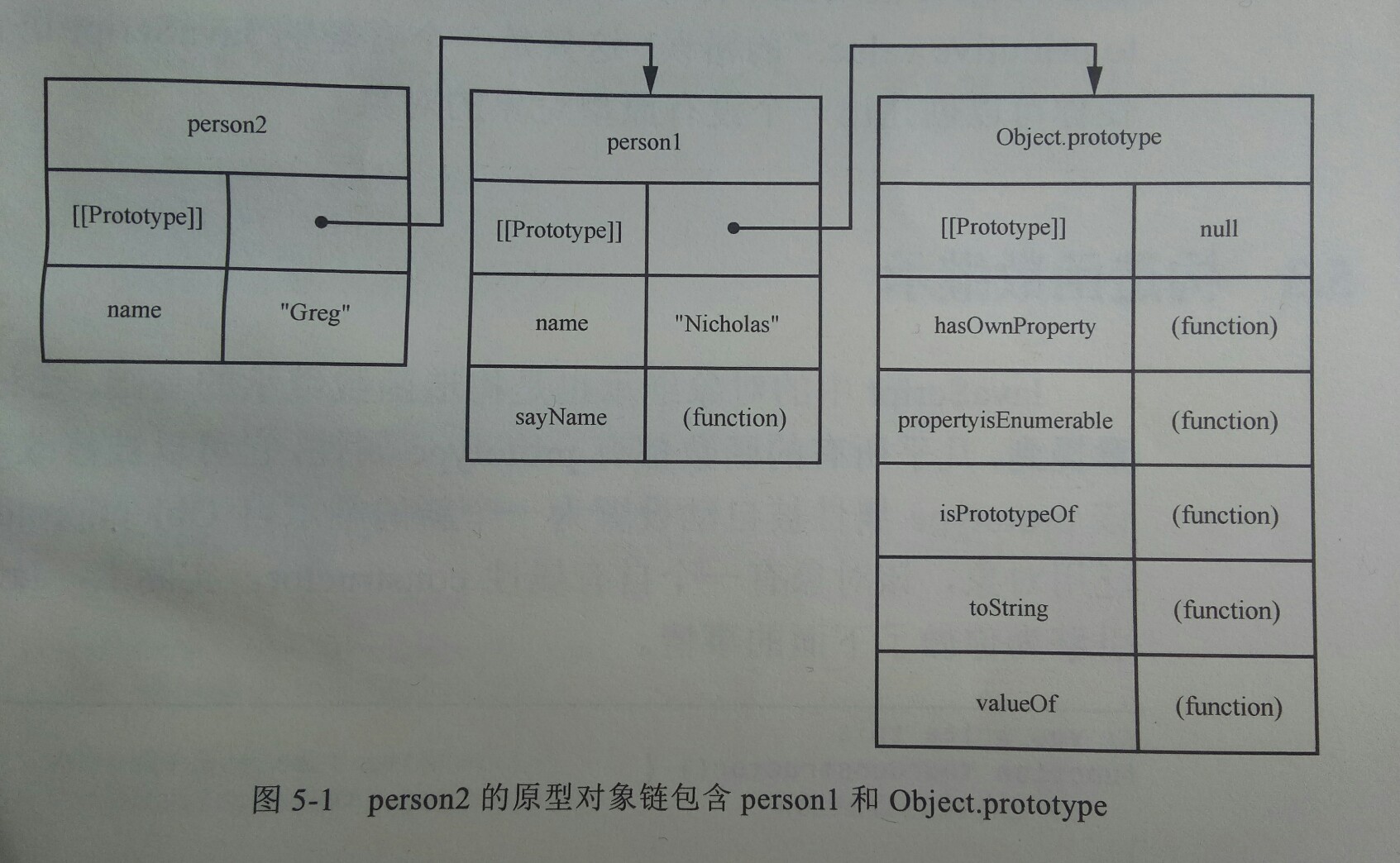javascript 面向对象精要 第五章 继承
2018-04-02 16:39
288 查看
[align=center] 第五章 继承[/align]引言: 理解面向对象编程 第一步 创建对象 第二步 理解继承
5.1 原型对象链和Object.prototype
Javascript内建的继承方法被称为原型对象链,又可称为原型对象继承。
原型对象的属性可经由对象实例访问,这就是继承的一种形式。原型对象也是一个对象,它也有自己的原型对象并继承其属性,这就是原型对象链。
所有的对象包括你自己定义的对象,都自动继承自Object,除非你另有指定。任何以对象字面形式定义的对象,其[[prototype]]属性的值都被设为Object.prototype.如下面例子所示:var book={
title:"tonghua"
};
var prototype=Object.getPrototypeOf(book);
console.log(prototype===Object.prototype);运行结果如下:

5.1.1 继承自Object.prototype的属性
5.1.2 修改Object.prototype
修改Object.prototype会影响所有的对象Object.prototype.add=function(value){
return this+value;
}
var book={
title:"tonghua"
};
console.log(book.add(5));
console.log("title".add("end"));
console.log(docunment.add(true));
console.log(window.add(5));运行结果如下:

添加Object.prototype.add()会导致所有的对象都有了一个add()方法。另外,Object.prototype.add()是一个可枚举属性,意味着它会出现在for in循环中,一个空对象仍然会输出“add"作为其属性,因为它存在与原型对象中并且可枚举。var empty={};
for (var property in empty){
console.log(property);
}

因为这个原因,推荐在for in 循环中始终使用hasOwnProperty(),如下:var empty={};
for (var property in empty){
if(empty.hasOwnProperty(property)){
console.log(property);
}
}这个方法虽然可以过滤那些不想要的原型对象的属性,但同时也限制了for in 循环。所以,最好不要修改原型属性/
5.2 对象继承
最简单的一种继承类型。唯一要做的就是指定哪个对象是新对象的[[prototype]].
隐式:字面形式
显式:Object.create() 接收2个参数 第一个参数:需要被设置为新对象的[[prototype]].的对象 第二个参数:可选 属性描述对象
var person1={
name:"Nicholas",
sayName: function(){
console.log(this.name);
}
};
var person2=Object.create(person1,{
name:{
configurable:true,
enumerable:true,
value:"Greg",
writable:true
}
});
person1.sayName();
person2.sayName();
console.log(person1.isPrototypeOf(person2));
console.log(person1.hasOwnProperty("sayName"));
console.log(person2.hasOwnProperty("sayName"));运行结果如下:

分析:对象person2继承了person1,也继承了name He sayName().然而person2在通过Object.create()创建时还定义 一个自有属性name,该自有属性隐藏并代替了原型对象的同名属性。
但是sayName()仍然只存在于person1并被person2继承。

当访问一个对象的属性时,javascript引擎会执行一个搜索过程。如果在该对象实例上发现该属性,,该属性值就会被利用,如果没有,则搜索[[prototype]],如果还是没有发现,则继续搜索该原型对象的[[prototype]],直到继承链末端。末端一般是一个object.prototype,其[[prototype]]被设置为null。
5.3 构造函数继承
几乎所有函数都有
// initialization
}
// JavaScript引擎在背后为你做了这些处理
YourConstructor.prototype = Object.create(Object.prototype, {
constructor: {
configurable: true,
enumerable: true,
value: YourConstructor,
writable: true
}
});由于prototype 属性可写,你可以通过改写他来改变原型对象链。function Rectangle(length, width){
this.length = length;
this.width = width;
}
Rectangle.prototype.getArea = function(){
return this.length * this.width;
};
Rectangle.prototype.toString = function(){
return "[Rectangle " + this.length + "x" + this.width + "]";
};
// inherits from Rectangle
function Square(size){
this.length = size;
this.width = size;
}
Square.prototype = new Rectangle();
// 尽管是 Square.prototype 是指向了 Rectangle 的对象实例,即Square的实例对象也能访问该实例的属性(如果你提前声明了该对象,且给该对象新增属性)。
// Square.prototype = Rectangle.prototype;
// 这种实现没有上面这种好,因为Square.prototype 指向了 Rectangle.prototype,导致修改Square.prototype时,实际就是修改Rectangle.prototype。
console.log(Square.prototype.constructor); // 输出 Rectangle 构造函数
Square.prototype.constructor = Square; // 重置回 Square 构造函数
console.log(Square.prototype.constructor); // 输出 Square 构造函数
Square.prototype.toString = function(){
return "[Square " + this.length + "x" + this.width + "]";
}
var rect = new Rectangle(5, 10);
var square = new Square(6);
console.log(rect.getArea()); // 50
console.log(square.getArea()); // 36
console.log(rect.toString()); // "[Rectangle 5 * 10]", 但如果是Square.prototype = Rectangle.prototype,则这里会"[Square 5 * 10]"
console.log(square.toString()); // "[Square 6 * 6]"
console.log(square instanceof Square); // true
console.log(square instanceof Rectangle); // true
console.log(square instanceof Object); // true运行结果如下:

分析:上述代码里有两个构造函数,Square构造函数的prototype属性被改写为Rectangle的一个对象实例。
rect作为Rectangle的实例对象被创建。square作为Square的实例对象被创建.两个对象都有getArea()方法,因为那继承自Rectangle.prototype.instanceOf操作符,认为变量square同时是Square\Rectangle、Object的对象实例。
唯一相关的部分就是,Square.prototype需要指向Rectangle.prototype,使得继承得以实现。

5.4 构造函数窃取
如果需要在子类构造函数中调用父类的构造函数。用call()或者apply().function Rectangle(length,width){
this.length=length;
this.width=width;
}
Rectangle.prototype.getArea=function(){
return this.length*this.width;
};
Rectangle.prototype.toString=function(){
return "[Rectangle "+this.length+"x"+this.width+"]";
a972
};
function Square(size){
Rectangle.call(this,size,size);
}
Square.prototype=Object.create(Rectangle.prototype,{
constructor:{
configurable:true,
enumerable:true,
value:Square,
writable:true
}
});
Square.prototype.toString=function(){
return "[Square "+this.length+"x"+this.width+"]";
};
var Square=new Square(6);
console.log(Square.length);
console.log(Square.width);
console.log(Square.getArea());运行结果如下:

分析:Square 构造函数调用了Rectangle构造函数,并传入了this 和size 两次,一次为length一次为width ,你可以在调用完父类的构造函数后继续添加新的属性或者覆盖已有的属性。Square类型有自己的toString()方法隐藏了其原型对象的toString()方法。
5.5 访问父类方法
上例中,Square类型有自己的toString()方法隐藏了其原型对象的toString()方法。如果还是想访问父类的方法该怎么办?
通过call()和apply()方法调用父类的原型对象的方法时传入一个子类的对象function Rectangle(length,width){
this.length=length;
this.width=width;
}
Rectangle.prototype.getArea=function(){
return this.length*this.width;
};
Rectangle.prototype.toString=function(){
return "[Rectangle "+this.length+"x"+this.width+"]";
};
function Square(size){
Rectangle.call(this,size,size);
}
Square.prototype=Object.create(Rectangle.prototype,{
constructor:{
configurable:true,
enumerable:true,
value:Square,
writable:true
}
});
Square.prototype.toString=function(){
var text= Rectangle.prototype.toString.call(this)
return text.replace("Rectangle","Square");
};
var Square=new Square(6);
console.log(Square.length);
console.log(Square.width);
console.log(Square.getArea());
console.log(Square.toString());运行结果如下:

5.1 原型对象链和Object.prototype
Javascript内建的继承方法被称为原型对象链,又可称为原型对象继承。
原型对象的属性可经由对象实例访问,这就是继承的一种形式。原型对象也是一个对象,它也有自己的原型对象并继承其属性,这就是原型对象链。
所有的对象包括你自己定义的对象,都自动继承自Object,除非你另有指定。任何以对象字面形式定义的对象,其[[prototype]]属性的值都被设为Object.prototype.如下面例子所示:var book={
title:"tonghua"
};
var prototype=Object.getPrototypeOf(book);
console.log(prototype===Object.prototype);运行结果如下:

5.1.1 继承自Object.prototype的属性
| hasOwnProperty() | 检查是否存在一个给定名字的自有属性 |
| propertyIsEnumerable() | 检查一个自有属性是否可枚举 |
| isPrototypeOf() | 检查一个对象是否是另一个对象的原型对象 |
| valueOf() | 返回一个对象的表达式值 |
| toString() | 返回一个对象的字符串表达式 |
修改Object.prototype会影响所有的对象Object.prototype.add=function(value){
return this+value;
}
var book={
title:"tonghua"
};
console.log(book.add(5));
console.log("title".add("end"));
console.log(docunment.add(true));
console.log(window.add(5));运行结果如下:

添加Object.prototype.add()会导致所有的对象都有了一个add()方法。另外,Object.prototype.add()是一个可枚举属性,意味着它会出现在for in循环中,一个空对象仍然会输出“add"作为其属性,因为它存在与原型对象中并且可枚举。var empty={};
for (var property in empty){
console.log(property);
}

因为这个原因,推荐在for in 循环中始终使用hasOwnProperty(),如下:var empty={};
for (var property in empty){
if(empty.hasOwnProperty(property)){
console.log(property);
}
}这个方法虽然可以过滤那些不想要的原型对象的属性,但同时也限制了for in 循环。所以,最好不要修改原型属性/
5.2 对象继承
最简单的一种继承类型。唯一要做的就是指定哪个对象是新对象的[[prototype]].
隐式:字面形式
显式:Object.create() 接收2个参数 第一个参数:需要被设置为新对象的[[prototype]].的对象 第二个参数:可选 属性描述对象
var person1={
name:"Nicholas",
sayName: function(){
console.log(this.name);
}
};
var person2=Object.create(person1,{
name:{
configurable:true,
enumerable:true,
value:"Greg",
writable:true
}
});
person1.sayName();
person2.sayName();
console.log(person1.isPrototypeOf(person2));
console.log(person1.hasOwnProperty("sayName"));
console.log(person2.hasOwnProperty("sayName"));运行结果如下:

分析:对象person2继承了person1,也继承了name He sayName().然而person2在通过Object.create()创建时还定义 一个自有属性name,该自有属性隐藏并代替了原型对象的同名属性。
但是sayName()仍然只存在于person1并被person2继承。

当访问一个对象的属性时,javascript引擎会执行一个搜索过程。如果在该对象实例上发现该属性,,该属性值就会被利用,如果没有,则搜索[[prototype]],如果还是没有发现,则继续搜索该原型对象的[[prototype]],直到继承链末端。末端一般是一个object.prototype,其[[prototype]]被设置为null。
5.3 构造函数继承
几乎所有函数都有
prototype属性,它可被修改或替换。该
prototype属性被自动设置为一个新的继承自
Object.prototype的泛用对象,该对象(原型对象)有一个自有属性
constructor。实际上,JavaScript 引擎为你做了下面的事情function YourConstructor(){
// initialization
}
// JavaScript引擎在背后为你做了这些处理
YourConstructor.prototype = Object.create(Object.prototype, {
constructor: {
configurable: true,
enumerable: true,
value: YourConstructor,
writable: true
}
});由于prototype 属性可写,你可以通过改写他来改变原型对象链。function Rectangle(length, width){
this.length = length;
this.width = width;
}
Rectangle.prototype.getArea = function(){
return this.length * this.width;
};
Rectangle.prototype.toString = function(){
return "[Rectangle " + this.length + "x" + this.width + "]";
};
// inherits from Rectangle
function Square(size){
this.length = size;
this.width = size;
}
Square.prototype = new Rectangle();
// 尽管是 Square.prototype 是指向了 Rectangle 的对象实例,即Square的实例对象也能访问该实例的属性(如果你提前声明了该对象,且给该对象新增属性)。
// Square.prototype = Rectangle.prototype;
// 这种实现没有上面这种好,因为Square.prototype 指向了 Rectangle.prototype,导致修改Square.prototype时,实际就是修改Rectangle.prototype。
console.log(Square.prototype.constructor); // 输出 Rectangle 构造函数
Square.prototype.constructor = Square; // 重置回 Square 构造函数
console.log(Square.prototype.constructor); // 输出 Square 构造函数
Square.prototype.toString = function(){
return "[Square " + this.length + "x" + this.width + "]";
}
var rect = new Rectangle(5, 10);
var square = new Square(6);
console.log(rect.getArea()); // 50
console.log(square.getArea()); // 36
console.log(rect.toString()); // "[Rectangle 5 * 10]", 但如果是Square.prototype = Rectangle.prototype,则这里会"[Square 5 * 10]"
console.log(square.toString()); // "[Square 6 * 6]"
console.log(square instanceof Square); // true
console.log(square instanceof Rectangle); // true
console.log(square instanceof Object); // true运行结果如下:

分析:上述代码里有两个构造函数,Square构造函数的prototype属性被改写为Rectangle的一个对象实例。
rect作为Rectangle的实例对象被创建。square作为Square的实例对象被创建.两个对象都有getArea()方法,因为那继承自Rectangle.prototype.instanceOf操作符,认为变量square同时是Square\Rectangle、Object的对象实例。
唯一相关的部分就是,Square.prototype需要指向Rectangle.prototype,使得继承得以实现。

5.4 构造函数窃取
如果需要在子类构造函数中调用父类的构造函数。用call()或者apply().function Rectangle(length,width){
this.length=length;
this.width=width;
}
Rectangle.prototype.getArea=function(){
return this.length*this.width;
};
Rectangle.prototype.toString=function(){
return "[Rectangle "+this.length+"x"+this.width+"]";
a972
};
function Square(size){
Rectangle.call(this,size,size);
}
Square.prototype=Object.create(Rectangle.prototype,{
constructor:{
configurable:true,
enumerable:true,
value:Square,
writable:true
}
});
Square.prototype.toString=function(){
return "[Square "+this.length+"x"+this.width+"]";
};
var Square=new Square(6);
console.log(Square.length);
console.log(Square.width);
console.log(Square.getArea());运行结果如下:

分析:Square 构造函数调用了Rectangle构造函数,并传入了this 和size 两次,一次为length一次为width ,你可以在调用完父类的构造函数后继续添加新的属性或者覆盖已有的属性。Square类型有自己的toString()方法隐藏了其原型对象的toString()方法。
5.5 访问父类方法
上例中,Square类型有自己的toString()方法隐藏了其原型对象的toString()方法。如果还是想访问父类的方法该怎么办?
通过call()和apply()方法调用父类的原型对象的方法时传入一个子类的对象function Rectangle(length,width){
this.length=length;
this.width=width;
}
Rectangle.prototype.getArea=function(){
return this.length*this.width;
};
Rectangle.prototype.toString=function(){
return "[Rectangle "+this.length+"x"+this.width+"]";
};
function Square(size){
Rectangle.call(this,size,size);
}
Square.prototype=Object.create(Rectangle.prototype,{
constructor:{
configurable:true,
enumerable:true,
value:Square,
writable:true
}
});
Square.prototype.toString=function(){
var text= Rectangle.prototype.toString.call(this)
return text.replace("Rectangle","Square");
};
var Square=new Square(6);
console.log(Square.length);
console.log(Square.width);
console.log(Square.getArea());
console.log(Square.toString());运行结果如下:

相关文章推荐
- Javascript面向对象之四 继承
- JavaScript面向对象继承方法
- JavaScript面向对象继承方法
- JavaScript面向对象之Prototypes和继承
- JavaScript 面向对象之继承
- javascript 面向对象基础(四)面向对象的继承
- 第五章 面向对象的编程风格(不带继承的多态)
- JavaScript面向对象(二):继承
- Atlas学习手记(28):JavaScript面向对象的扩展(二):继承Inheritance
- JavaScript高级程序设计之面向对象的程序设计之继承之原型链 第6.3.1讲笔记
- javascript 面向对象精要 第一章 原始类型和引用类型
- javascript面向对象之Javascript 继承
- JavaScript面向对象------继承
- JavaScript面向对象中的属性,对象创建,继承
- 面向对象的JavaScript系列二,继承
- JavaScript面向对象初探——原型链、封装和继承
- JavaScript 中级笔记 第五章 面向对象的基础
- 详解JavaScript基于面向对象之继承实例
- Javascript 面向对象二:继承
- javaScript面向对象-继承
